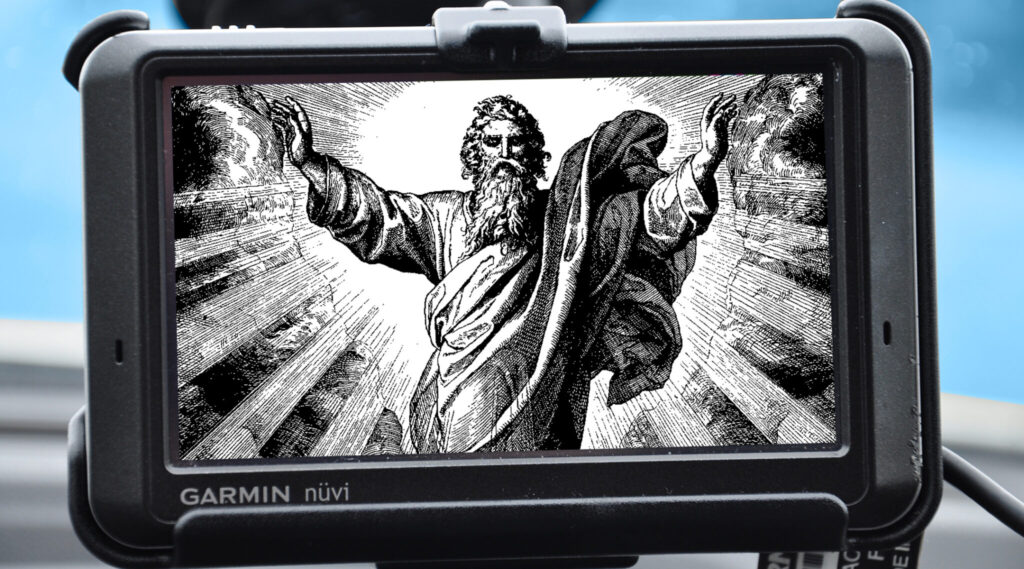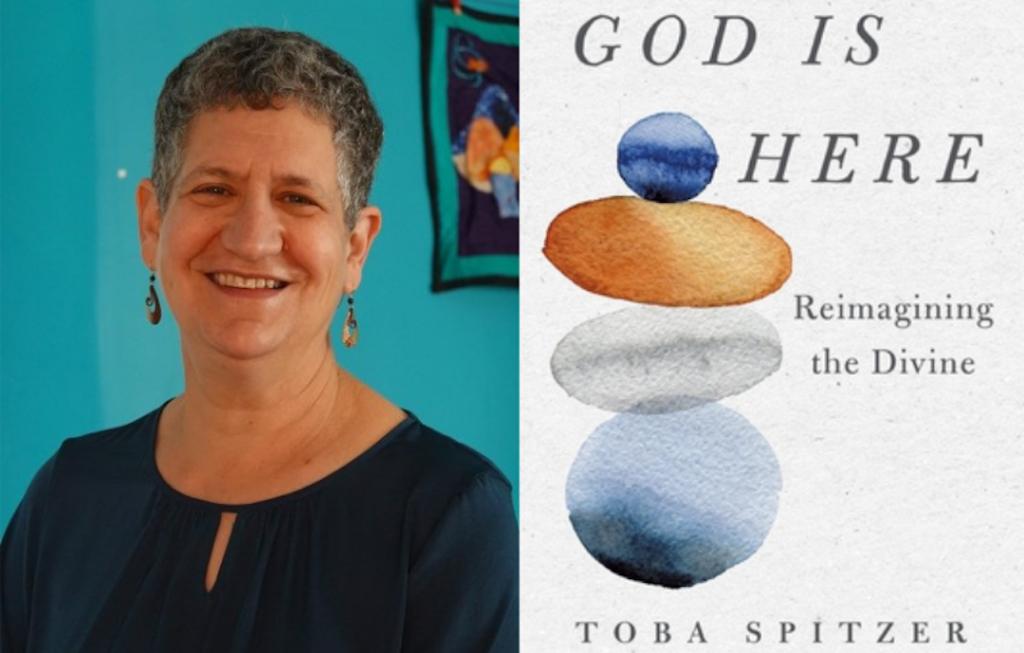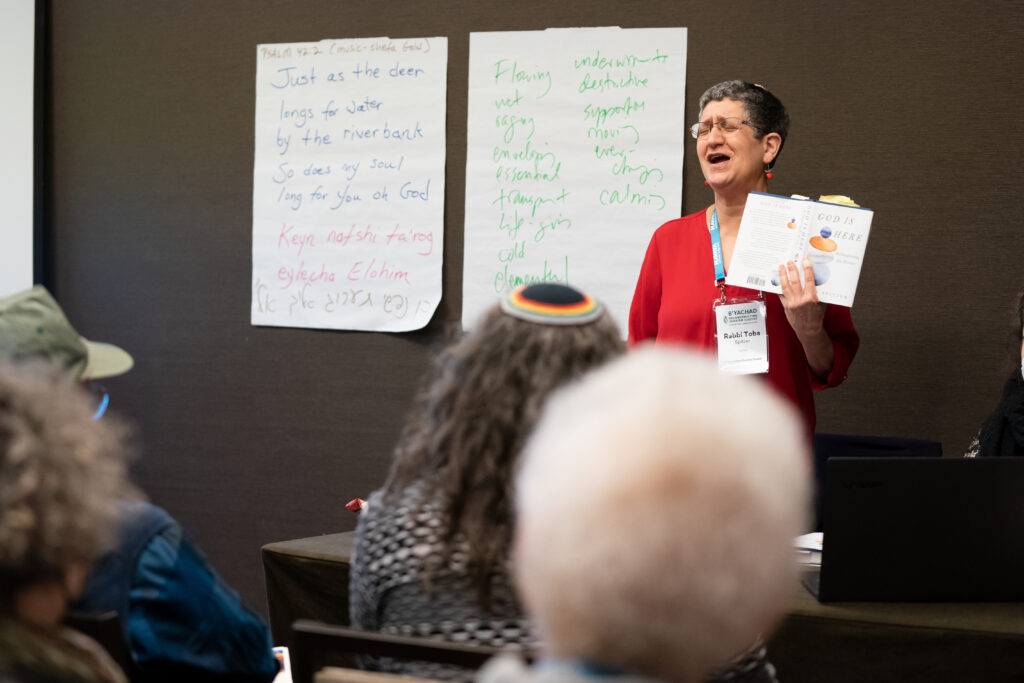The following interview with Rabbi Toba Spitzer originally appeared Sept. 25, 2022 on JTA.org.
One of the centerpieces of the Rosh Hashanah and Yom Kippur liturgy is the “Avinu Malkeinu” prayer — Our Father, Our King. It’s a desperate and emotional appeal for forgiveness, set to powerful melodies over the centuries.
It’s also a hurdle for many people, regular and occasional synagogue-goers alike. Some can’t relate to a “king,” or bristle at the gendered implications of “father.” Whatever they hoped to feel or achieve in prayer is undermined by the archaic language and metaphors that don’t speak to them.
That’s the challenge described in Rabbi Toba Spitzer’s new book, “God Is Here: Reimagining the Divine.” The spiritual leader of Congregation Dorshei Tzedek in Newton, Mass., Spitzer understands how the language of Jewish prayer can stand in the way of the meaningful spiritual experience many people are seeking. Her solution is to “dislodge” unhelpful metaphors of prayer and look for meaning in different ones — ancient and modern — in ways that help people think and talk about “something that is greater than ourselves.”

The book asks what might be useful if we were to think of God as water, or fire, or a place, or yes, even a king. All are metaphors for God found in the Torah and the Jewish prayer book. You don’t need to ask whether you believe that God is a parent or a monarch, she says, but rather explore where the poetry of metaphor can take you. “My hope,” she writes, “is that we can recapture the alive-ness which once pervaded our holy texts, and reconstruct our metaphors so that they are once again engaging and meaningful.”
There is some foundational human experience of the sacred that’s existed at all times and at all places. And at some point, people started using metaphors to think about and interact with that experience.
Spitzer is the past president of the Reconstructionist Rabbinical Association — the first LGBTQ rabbi to head a national rabbinic organization. She spoke with me via Zoom.
Our conversation has been edited for length and clarity
Jewish Telegraphic Agency: It’s the High Holidays. People find themselves in a synagogue for the first time all year, where even regular synagogue-goers face that firehose of liturgical language that may not speak to them. For both sets of people, there may be a sense that the Iron Age metaphors of the prayer book — God is king, heavenly father, shepherd, or even a potter — don’t resonate with them. You say “people don’t have a God problem as much as a metaphor problem.” Can you explain that?
Rabbi Toba Spitzer: When I started this journey into metaphor and cognitive linguistics, I realized, and this is a quote from the anthropologist Barbara J. King, that “the religious imagination thrives on the human yearning to enter into emotional experience with some force vaster than ourselves.” There is some foundational human experience of the sacred that’s existed at all times and at all places. And at some point, people started using metaphors to think about and interact with that experience:
“God is a big person” or “God’s an old man in the sky.” It’s not that that is a bad metaphor, but there are some problematic aspects to it. Or the “king” one: I think Americans have a huge problem with royalty. We’re trained to not like authority so it doesn’t work for a lot of Americans.

So the metaphor problem is, “Wow, I do have spiritual experiences. I do want to feed my spirit. And then I turned to a metaphor that doesn’t work for me, what do I do?”
I use this analogy of a restaurant — like I just walk out of the restaurant, because there’s nothing on the menu that satisfies me. And yet our ancestors had a much richer palette of metaphors to choose from that could convey their experiences of the sacred. So, the book is nothing new. It is just trying to say, what if we took these other metaphors seriously?
So, when you try to reclaim metaphors, you’re still drawing on some of those found in tradition: God is fire, or a warrior, or an eagle, water, a rock.
I want to reclaim all of it. In the first couple of chapters I lay out this argument, which is the argument of cognitive linguists George Lakoff and Mark Johnson, that in order to apprehend reality and get our minds around abstract things, we need metaphor. I feel like these were metaphors that were very alive in our ancestors’ lives and not just words on the page, so it’s not surprising a lot of them are from the natural world. I tried out more modern ones, like electricity and GPS, but I love the ancient ones.
I think the big theme of Rosh Hashanah is like, “I’m not the center of the universe. There’s something much bigger than me.” So what did a king represent to the ancients? Something powerful, someone who held the power of life and death in their hands, but who is also largely beneficent.
I want to dig into a few of those in a second, but I like your framing of how to deal with doubt. Instead of asking, “Do I believe this?” we can ask of a prayer: “Where is this trying to take me?” How might that work in practice?
Let’s go back to the High Holidays and some of the human metaphors. We say, “Our Father, our King.” Do I believe God is a king? No. But if I say this is poetry and my ancestors were trying to evoke something, it takes me to a few directions. I think the big theme of Rosh Hashanah is like, “I’m not the center of the universe. There’s something much bigger than me.” So what did a king represent to the ancients? Something powerful, someone who held the power of life and death in their hands, but who is also largely beneficent. The High Holiday liturgy is asking me to confront my mortality and confront the fact that I’m extremely, extremely miniscule in the scheme of the cosmos. I was just doing some research and found that referring to God as a king in the Roman period was subversive — at a time when the Roman emperor was considered God. So the metaphor is saying that while we have earthly rulers, there’s something higher than that. So even if the word “king” might not work for me, that’s powerful, and I want to go in that direction.

How might that work with water, which you write is one of the most common metaphors for God in the Hebrew Bible, as in Psalm 42: “As the deer longs for water, so does my soul long for You, O God.”
Water adds a few things. We say we are created in God’s image, and I’m 70% water. There is sacred stuff literally flowing through me. So that’s one piece. And that psalm leads me to ask, how am I dry? How do I nourish myself spiritually, what do I need? Water is also a metaphor for godly power in the Bible. If in the Bible, God’s justice is often imagined as water, how do we align ourselves with the flow? How do I get my values and my actions aligned in the new year? Right now in New England, we’re in a drought and in other parts of the world they are getting too much water. That’s scary, and God is scary. So it’s both: We need both a sense of awe and sustenance, and as we move through the High Holidays, those two pieces are a big part of the liturgy.
You write that in the early rabbinic period, or the first two centuries of the Common Era, the term “HaMakom” — “The Place” — had become a fairly well-known Jewish name for God. I always thought of it as just a euphemism and not really a metaphor, the way the people in Harry Potter’s world talk about “the one who shall not be named.” How is it useful to think of a place as a metaphor for God?
The rabbi’s call [God] that for two reasons. One is because wherever you are, there’s godliness. The rabbis were in a period when the Holy Place — literally, the Temple — had been destroyed and they were recreating connections to the Divine everywhere. So literally HaMakom was where we experienced the Divine in every place. It’s always associated with compassion, and a sense of God’s nearness. I’ve found that when people are in distress, whatever they think or don’t think about God, I ask them to describe for me experiences of the sacred. And they almost always talk about places. I think it’s very easy for most people to conjure up places where they feel sheltered, where they feel a sense of wonder or the sacred. Place is very accessible.
Do you worry that if you do away with what you call the “God is a big person” metaphor, it risks making God less personal? Nature metaphors are lovely, but can they blur the intimate relationship many people hope to have with God?
I’m really not trying to get rid of any metaphors. Sometimes, you know, I want God to hold my hand or I want to feel like I’m being embraced by the Beloved or or loved by, you know, a cosmic mother or whatever it is. I don’t want to get rid of those metaphors. I think the specific metaphor of God as a distant emperor, which has sort of somehow got more dominant in Jewish tradition, is problematic because it says tyrannical power is godly. But yes, we want a deep personal connection, and the idea that God is a teacher or a lover or parent is beautiful.
Human metaphors do not deal well, for instance, with the whole realm of theodicy, the whole realm of “when bad things happen to good people.” Because then you are stuck with, “Why is this happening to me?” or “Why is God doing this to me?” Or, “If God is good, how could God allow this to happen?” Those are just not useful questions. By contrast, when I was going through my own heartache and hard times, the water metaphor said to me, “Okay, I’m in the water, the water is godly. It’s also totally overwhelming. How do I navigate this?” That’s a really useful question.
Can the search for new or different metaphors be pushed too far? Can you stretch the definition of God in such a way that it’s no longer God as understood by Jewish tradition? If God is water, can water create and control the universe or enter into a covenant with Abraham and Sarah or punish the Israelites for the Golden Calf, as we are told in the Bible?
Metaphors are not definitions. In the ancient Near East, every divinity had multiple ways of being represented. And again, I think the ancients had a much more direct experience of the Divine than we can even imagine. And they knew they needed lots of metaphors, and that’s why our scriptures are filled with them.
But we need all these metaphors because different ones speak to different experiences. Fire is often a metaphor for God’s anger. We need to deal with anger. There is such a thing as holy anger and unholy anger and even holy anger can lead to destruction. That’s what many of the biblical stories show us. I think that metaphor is much more useful to me than, like, “the angry old man.” Because I understand fire. I understand how fire is completely necessary to human life and could burn you really quickly. Most people can wrap their heads around that and then think about divine fire or holy anger in a totally different way than like, “why is God mad at me?” which again, is not useful at all.
My friend Rabbi David Nelson wrote a book a few years ago called “Judaism, Physics and God,” in which he drew on metaphors from modern science to describe God, like God is a fractal, or God is a neural network connecting billions of human consciousnesses. Do you encourage people to find metaphors in current technology or society, like, I don’t know, God is a life coach or something like that?
You know, whatever works for people. For a metaphor to be something we live by, we need to really make it active in our lives. I use GPS as a metaphor because it’s really useful. There’s three parts of GPS: There’s the location part: Where am I? That’s the spiritual question. There’s the map: How do I find my way from here to there? That’s spiritual practice. And then there’s the crowdsource: people telling me where the bumps in the road are or where the cop car is. That’s the community. I found that all of a sudden that metaphor was really useful. So I totally encourage people to dive into a metaphor, knowing that what may resonate with you today may not feel useful tomorrow.
is editor in chief of the New York Jewish Week and senior editor of the Jewish Telegraphic Agency. He previously served as JTA’s editor in chief and as editor in chief and CEO of the New Jersey Jewish News. @SilowCarroll







